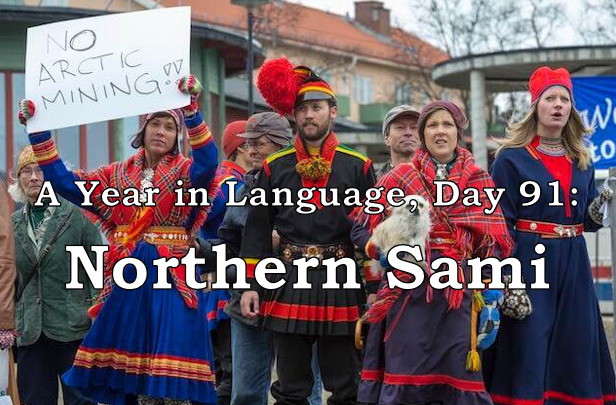ayearinlanguage:A Year in Language, Day 91: Northern SamiNorthern Sami has the most speakers of any
ayearinlanguage:A Year in Language, Day 91: Northern SamiNorthern Sami has the most speakers of any Sami language, a branch of the Finno-Ugric language family which also includes Finnish and Hungarian. The Sami are an ethnic group found across northern Scandinavia. They likely predate the incursion of Germanic speaking Norsemen to the region and are related to Finns.Northern Sami has an interesting system of length in both its vowels and consonants, which interacts both with length, phoneme clusters, and syllable boundaries. For the consonants there are 3 grades of length which account for both the length of individual consonants and for the length of given consonants in a cluster, and where the syllable is divided should they fall between two. It should be noted that these three grades are not short, long, and overlong consonants (though there are such languages) but differing pairs of short and long consonants in clusters. The grades are determined by the internal phonetic rules of the language which entail different grammatical processes for each one.In linguistics a “diphthong”, which is my favorite word to say, is a kind of fused double vowel. The best way to understand a diphthong as separate from just two vowels in sequence is to break a vowel down into a nucleus, i.e. the core sound of the vowel, and an onset or offset, a kind of transitional state to or from the nucleus. A monopthong, your standard singular vowel, is a pure nucleus with no distinct on/offset. An example in English is the /a/ of “raw”, which though written “aw” is just one vowel, at least in my dialect. A diphthong however has a distinct on/offset. In English this includes the vowel of the word “ray”. The nucleus is written phonetically as /e/ and is identical to how the letter “e” is pronounced in Spanish. However in English, right as the vowel ends we tighten it up into /i/. Finnish has four diphthongs and five monopthongs. Four of those five, each one corresponding to one of the diphthongs, contrast in length, short and long. You may recall that I often speak of phonological patterns being more significant than the actual phonetics of the sounds created, and that’s true here as well. The diphthongs in Sami do not actually contrast short and long, but they pattern in all the same ways that the monopthong short and long do, thus it may be more accurate to say that in Sami a “short” diphthong has a nucleus and an offset, and when they become “long” the offset become the nucleus and the former nucleus becomes the onset.Northern Sami is an agglutinative language, though may be transitioning to a synthetic one (I wrote of a similar transition occurring in Estonian). The word order is Subject Verb Object (SVO) and it has a system of seven cases. Northern Sami has seen several adaptations of the Roman alphabet. The current iteration uses a unique letter “Ŧ/ŧ” to represent the voiceless /θ/ sound (ex. English “thin”) as opposed to a digraph or the more traditional letter Thorn still used in Icelandic. This letter is designed in analogy with the traditional letter used for the voiced equivalent /ð/, written “Đ/đ” -- source link
Tumblr Blog : ayearinlanguage.tumblr.com
